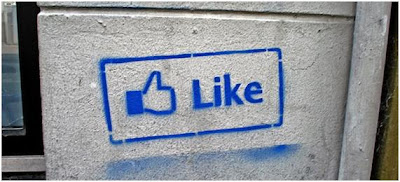When you custom-create a message that touches your consumer, you get to choose your call to action. Your website, ads, pitches, and content, all give you an opportunity to ask something of your potential customers or clients.
More and more frequently, that call to action is this: Like us on Facebook.
But when you create anything that communicates with your audience, you can’t just consider WHAT your call to action is – more importantly, you have to consider WHY.
So let’s explore that. Why does everyone want their audience to “Like them on Facebook”? …And is it the best “call to action” for your potential customers and clients?
Since its introduction, the Like button has provided as many difficulties as it has opportunities for brands. We’ve seen a proliferation of Like buttons in marketing both offline and online, but often the call to action is completely lost or there seems to be no strategy behind the placement of this. The temptation to make the Like button centre stage because of its ease of use, and the option to tick the social media box when it’s done, can be dangerous for brands who risk missing out on the real potential.
Likes = Popularity
We know that the most popular brands have the most Facebook likes. Millions and millions of users have used their Facebook page to show their support of brands like Disney, and Coca-Cola.
BUT here’s the catch: These brands’ popularity came first – not the Facebook likes. If Facebook had never existed, these brands would still be popular. They’d still thrive. So basically, the “likes” represent existing brand loyalty. They show that the brand is popular, but they aren’t the reason the brand is popular.
Earning the like does not guarantee that the individual turns into a lead or becomes a customer, as it is incredibly difficult to get this traffic to return to your site.What it does mean is that the individual has opted-in and therefore is allowing you to syndicate your Facebook posts on their news feed.
Stop Giving Away iPads!
In fact, ‘buying’ friends could hurt you in terms of Edge Rank (Edge Rank is the algorithm, or ‘secret sauce’, that determines what appears in people’s news feeds). The point is that having 1,000 new fans who never contribute to your page — don’t like your posts, don’t ever comment and never share anything you create — drag down your overall influence in getting onto news feeds.
Discounts for fans, rewards for sharing, and free samples are great ways many companies capitalize on their likes. BUT if you aren’t equipped to offer these things (and offer them well), maybe a better call to action is to visit your website, call for more information, or buy the product.
Don’t get me wrong; social mediais a powerful medium. Social proof and word of mouth are critical in any brand’s success and Facebook makes these things easy.
How Sexy is Your Photo?
Most business owners add their logo as a profile picture.
Not bad, but why not try adding a ‘Fan of the Week’ photo instead? The idea here is that you give the community a reason to comment and share with their friends and family (And with the average Facebook user having 245 friends, the potential for new fans grows exponentially with each new share).
Remember, you don’t have to sacrifice your logo, just marry it with a fan photo.
Having a Facebook “Like” Strategy is extremely important. But… What’s next?

No hay comentarios.:
Publicar un comentario